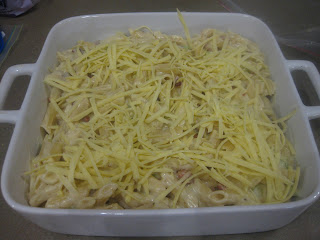We are currently on holiday in New Zealand, and so even though I have been doing some cooking while staying with my husband's sister, I haven't really had much chance to blog, so I took advantage of the time I had yesterday.
I knew that there were quite a few bits of cheese (including some mascarpone cheese) in the fridge, as well as some cooked bacon and a few partial heads of garlic. There was a small piece of blue cheese that I considered adding to the sauce, but I opted to pass it at the table, as not everyone likes blue cheese! Add in two stale buns and we had the makings of a rich and creamy baked mac n cheese, with a crumb topping. I used penne because that was the only pasta in the cupboard; it also happens to be my husband's favourite pasta shape!
Start off by cooking 500g of penne pasta in lightly salted boiling water. Put the garlic in the oven to roast (see the post Garlic for intructions). I had the equivalent of two heads of garlic.
While that is cooking, make the crust for the topping, and the sauce.
In a food processor, place:
2 stale buns, torn into pieces
Process until you have coarse breadcrumbs.
Add:
1/4 cup chopped fresh herbs; I used rosemary and chives
1/4 teaspoon salt
1/4 teaspoon black pepper
Process to combine.
Place the herb breadcrumbs into a large bowl, and add:
1 heaped cup of grated Parmesan
2 tablespoons olive oil
Mix to combine, and set aside until needed.
In a saucepan, melt:
2 ounces butter
Stir in:
1/3 cup flour
1/4 teaspoon salt
1/4 teaspoon black pepper
Cook over low heat, stirring, for a couple of minutes.
Gradually whisk in the milk. You will need:
2 - 3 cups
Add the milk gradually, whisking. As the sauce thickens add more milk, until you have a thick, creamy sauce. Allow it to come to a boil, whisking, and then turn off the heat.
Whisk in:
1/3 cup mascarpone cheese
Add:
2 cups grated Edam cheese
1/2 cup grated Paremsan
Whisk until the cheese is melted and the sauce is smooth. Taste and adjust seasoning.
When the pasta is cooked, drain it and return it to the pot. When the garlic is roasted, allow it to cool enough to handle, and then squeeze the cloves out of the skins.
To the pasta, add:
the roasted garlic
5 green onions, chopped
3/4 cup chopped cooked bacon
Pour the sauce over the pasta, and stir well.
Scrape the pasta and sauce into an ovenproof dish.
Sprinkle the top of the pasta with grated Edam cheese.
Spread the breadcrumb topping evenly over the cheese.
Bake at 350F until heated through, the sauce is bubbling and the breadcrumbs are golden and crunchy.
Serve, making sure everyone gets their share of crunchy topping. Pass crumbled blue cheese at the table, for those who want to add some extra tang to the pasta.
- The cheese sauce is a basic bechamel, with cheese added in. The consistency can be adjusted by adding more flour to give a thicker sauce, or more milk, to give a runnier sauce. For more on bechamel, see the post Basic White Sauce (Bechamel).
- The kind of cheese you add is dependent on what you like and what you have available, but I like to include a sharp or stronger tasting cheese along with a more gooey, melting cheese. Adding something like mascarpone increases the richness of the sauce.
- Spices can be added to the sauce...chili flakes, cayenne pepper, paprika, nutmeg are some you can try. Chopped fresh herbs such as thyme, parsley or chives can also be added.
- Another way to increase the richness of the sauce is to use creamo, or whipping cream, for some or all of the milk.
- Additions to the pasta can be adjusted to whatever you have to use up...chopped ham, fresh herbs, cubes of cheese, roasted tomatoes or sundried tomatoes, olives, artichokes, caramelized onions, diced and roasted squash or sweet potatoes, roasted red peppers.
- If you do not have breadcrumbs, or stale bread to make them, just sprinkle cheese on top of the pasta before baking.
- If you can, make extra breadcrumb topping and keep in the freezer for next time.
- Of course, any pasta shape can be used!
- Bake the pasta in individual dishes to serve as a side dish; these can also be frozen and baked when you are in need of a quick meal for one.





































